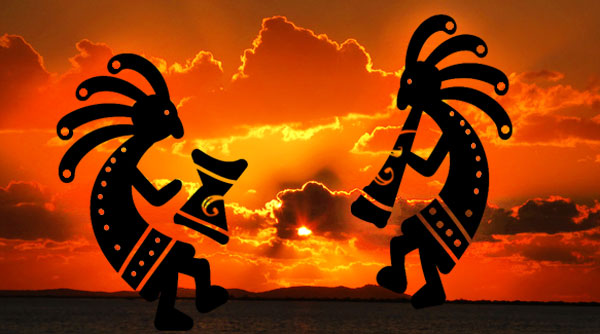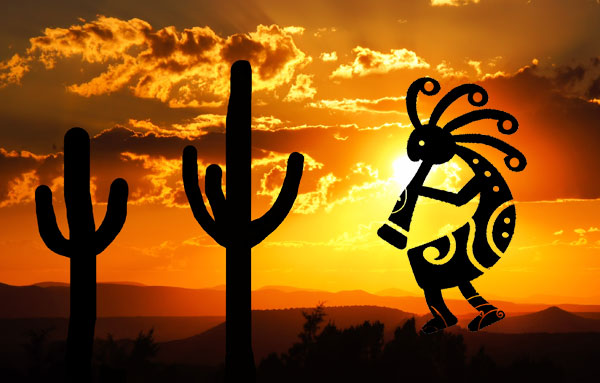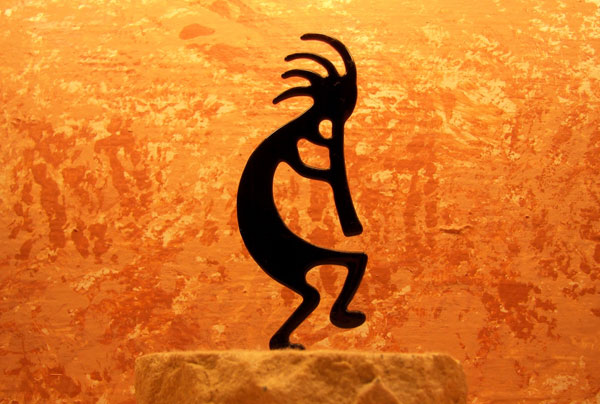Cuckoo for Kokopelli Meaning

Kokopelli Meaning
Exploring Kokopelli Meaning: Almost everybody is familiar with this funky little figure. Even if we don’t know what it means, the Kokopelli symbol has been widely embraced in human culture.
We see it stuck on patio walls and embroidered on socks. It has been a hip mascot for kitschy coffee shops and plays peek-a-boo on boho-chic clothing.
When I see Kokopelli festooned on t-shirts or plastered around pool-side decks, I wonder if the true meaning of this Native American deity was properly considered before it was donned as a decoration.
Case in point: I once lived in a duplex with a neighbor we’ll call Chuck. He nailed this giant neon-colored Kokopelli on his front door (which was adjacent to my door). One day, I asked him if he knew what this so-called decor implicated. I think my actual question was: “Dude, do you have any idea what that is, or what it means?”
With a glazed-over look and a grunt for a response, it was clear Chuck neither knew about Kokopelli meaning, nor cared. For him, it was just a quirky bit of brightly painted aluminum that made his front door look like the man behind it might not be the big bozo he really was (sorry Chuck, just sayin’).
If it sounds like I have my knickers in a twist over all the Chuck’s in the world who slap up a Kokopelli design (or any other sacred symbol) without respectful consideration to its meaning…well, you are very astute.
In truth, the Kokopelli is an ancient Native icon of power and influence. First seen inscribed on rocks in the American Southwest, the Kokopelli is a revered deity of the Anasazi, Pueblo, Hopi, Zuni, and other tribes. Its name is loosely translated to mean “hunched one” or “wooded back“.
The Kokopelli is believed to control or influence human lives in various ways, depending upon the tribe.
Keen Insights Into the Secret Life of Kokopelli
- Fluting for Fertility: The most common understanding of the Kokopelli is that it is a fertility god. This is true, but it’s not that simple. The Kokopelli’s flute is said to bring about magical music that blesses new life and helps insure new growth. But this isn’t always about encouraging human fertility. Kokopelli also influenced the successful growth of the prime crops of Southwest tribes: Beans, corn and squash. These crops were huge for these Native people. Why? Cuz if you ain’t got no beans, then you ain’t got no means. Sustaining food for a tribe was a life-or-death deal.
- Trick or Treat: Kokopelli also has a edgy, tricky side. This largely deals with the unpredictable ways of Nature. Before science peeled the veil off the mysteries of creation, ancient cultures often relied upon (and blamed) their gods for success or failure in life. In the case of Southwestern Native cultures, famine or infertility could only be explained by the fickle whims of Kokopelli. In other words, in the midst of death or drought, that meant tricky Kokopelli was clearly testing the tribe.
- Long Strange Trip: Whether birthing babies, planting peas, or writing a soul-stirring sonnet…the process of creation can get very trippy. Savvy Southwestern Natives realized this, and relied upon Kokopelli to be the way-maker for the flow of productivity and creativity. As a god of creativity, people looked to Kokopelli for inspiration and insurance for the birth of new life, ideas, art, etc.
In fact, that whimsical flute depicted with Kokopelli is also a pipe, which was believed to sometimes produce hallucinogenic states when smoked. Whether through music or ‘loco’ smoke, Kokopelli understood that the creative process demands a certain amount of looseness.
Let’s face it, we can’t control everything, and Kokopelli reminds us that this is okay. Sometimes we get a killer-awesome idea and wonder ‘where did that come from!?’. Or, we might be boggled by how we got blessed with a new birth out of the blue. Or, maybe we are baffled by that stroke of genius that leads to a brilliant business idea. You get the hint.
In the Native mind, these are divine gifts from Kokopelli combined with our commitment to trust that creativity needs to flow freely on its own trippy path. Kokopelli reminds us that creation (and creativity) cannot be controlled…sometimes we just need to go cuckoo for Kokopelli, get a little wild, and take the creative path wherever it might lead us.
These are just a few perspectives about depth and power represented by Kokopelli. At the end of the day, the energy of Kokopelli is something to be honored and respected.
So if a bozo named Chuck flippantly slaps a powerful deity on his door…that’s his business…but at least we all know the significance and intense meaning behind this highly-charged symbol.
As always, thanks for reading. If you liked this, you might want to read the full article on Kokopelli Meaning here.
And please feel free to share! I’d love the shout-out!
Stay wild, stay creative!
Brightly,
Avia



